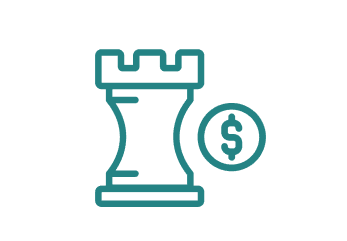Financial agility is no longer just a luxury—it’s a necessity in today’s market. While some companies focus solely on maximizing revenue and profit margins to assess their adaptability, optimizing your cash conversion cycle (CCC) is an excellent way to not only improve cash flow, but to enhance your company’s ability to weather economic uncertainty and take advantage of new market opportunities.
Why the Cash Conversion Cycle Matters
Sometimes called the cash cycle or the net operating cycle, the cash conversion cycle is a snapshot of an organization’s financial health. It divides a company’s entire process into stages to measure how long it takes for cash to flow out to suppliers and in from customers. Essentially, the CCC provides a valuable metric of how quickly a business can turn stock into sales.
Seamless cash flow is the key to maintaining liquidity, which increases both operational efficiency and the ability to scale as needed. By improving the cash conversion cycle, businesses can grow without taking on new debt and gain a market advantage during economic volatility.
A short CCC demonstrates efficient operations and a strong cash flow position. Because capital is not tied up for long periods, the business can take advantage of new opportunities as they arise. On the other hand, a long CCC might indicate that resources are being ineffectively used or working capital is tied up, which can lead to cash flow problems. A score of 25 or less is generally considered good.
Take, for example, Gymshark—a UK fitness apparel producer and retailer. With careful attention to detail, they have reduced their CCC into the negative numbers. Because of this, their cash flow position is so strong that they require no additional funding to scale their operations, as their customers are effectively paying their suppliers.
How to Optimize Each Component of the Cash Conversion Cycle
The cash conversion cycle divides its financial outlook into three components of time measurement, which work together to determine how effectively an organization manages its cash flow and working capital.
Days Inventory Outstanding (DIO)
Days Inventory Outstanding is the average number of days it takes a business to convert inventory into sales. Faster turnover is better: inventory that sits too long before being sold could be liquidity elsewhere. By shortening your DIO, you not only free up cash but also position your business to react quickly to market demands.
Methods to shorten the time it takes to turn stock into sales include:
- Implementing just-in-time (JIT) inventory systems. Acquiring inventory only as needed reduces the need for costly storage and frees up cash for operational needs.
- Leveraging data analytics to forecast demand and protect cash flow. Particularly during volatile markets, performing demand forecasts ensures you’ll neither be caught short nor sitting on too much inventory.
- Trying new marketing and advertising strategies to boost brand awareness and sales.
As an example, major U.S. retailers faced a surge in demand for home improvement-related goods during the pandemic, which initially seemed positive. However, accountants recognized this spike as temporary, so they adjusted inventory expectations to avoid overstocking. This prevented a significant increase in DIO—a key factor in maintaining an efficient CCC.
Days Sales Outstanding (DSO)
Days Sales Outstanding is the average number of days it takes a business to collect customer payments after a sale. The faster payment is collected, the smoother and more uninterrupted your cash flow.
Tactics to decrease the amount of time it takes to collect payment include:
- Automating your accounts receivable process. When invoicing is immediate and follow-ups are automatic, it’s easier to maintain cash flow.
- Incentivizing early payments. Offering deals to customers who pay quickly improves liquidity.
- Making it easy for customers to pay by offering multiple payment methods.
Days Payable Outstanding (DPO)
Days Payable Outstanding is the average number of days it takes your business to pay suppliers. The longer your payment period, the more cash you have on hand, which increases your liquidity.
Strategies to lengthen your own payment periods include:
- Negotiating more favorable terms with trusted suppliers. Acquiring extended payment terms enhances your financial flexibility.
- Taking advantage of any early payment discounts allows you to balance your cash flow and your supplier relationships for long-term stability.
Identifying Inefficiencies in Your Cash Conversion Cycle
The cash conversion cycle formula (DIO+DSO-DPO=CCC) provides business leaders with comprehensive visibility into how efficiently you’re managing cash flow. Even slight inefficiencies in your CCC can undermine your financial agility.
Common indicators of inefficiency include a lengthening CCC, which may signal issues like overstocking, slow payment collections or premature supplier payments. These inefficiencies can tie up capital and reduce your ability to respond to market changes.
To avoid these pitfalls, regularly benchmark your CCC against industry standards so you can adapt to changing market conditions. If your cash conversion cycle is longer than that of your peers, it’s time to reassess and implement corrective measures. Collaborate cross-functionally across teams to align strategies and ensure continuous optimization.
The Importance of Expertise & Cross-Functional Collaboration
Not every firm has the resources to devote to thoroughly researching and optimizing CCC. Mastering the cash conversion cycle isn’t a one-time task; it requires regular reassessment through expertise and concerted effort across departments, including Finance, Sales, Procurement and Inventory Management. Each plays a critical role in ensuring that the strategies implemented are effective and sustainable.
Additionally, finance consultants can offer valuable insights and help benchmark your CCC against peer and industry standards. They can also drive digital transformation initiatives, introducing technology solutions to streamline CCC processes, and implementing real-time data analytics to allow informed decision-making and quick responses to market changes.
By fostering strong communication and shared goals through internal teams and consultative expertise, your business can optimize its cash flow, reduce working capital costs and improve financial agility.
Stay Competitive with an Optimized Cash Conversion Cycle
Navigating periods of market uncertainty requires financial flexibility. Companies with a shorter CCC are better positioned to weather economic downturns, maintain liquidity and take new growth opportunities. The ongoing process to optimize your cash conversion cycle requires continuous monitoring and adjustment as market conditions evolve.
To stay competitive, regularly reassess your cash conversion cycle strategies and consider working with an expert consultant. Paro’s strategic advisory and fractional CFO services offer the expertise and strategic insights needed to optimize your CCC and maintain its competitive edge in any economic climate.








